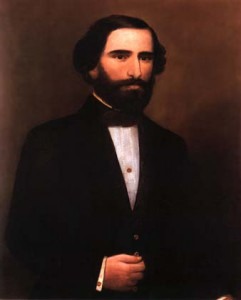
Giuseppe Verdi
Federico Ricci: La prigione die Edimburgo, Act 1, Scene 2
La prigione, first performed at the Teatro Grande in Trieste during carnival season of 1838, is an opera semiseria, which presents predominantly serious action yet includes one or more comic characters. As such, it is located between opera seria and opera buffa and might rightfully be considered a genuine example of melodrama (mixed drama). A local critic reported, “the music is vigorous and filled with feeling; hence distinctive in the highest degree, and of the greatest effect. It is a massive work, rich with melodies and harmonies; without confusion in its instrumentation and its vocal writing; in truth it is a magnificent music that penetrates, moves, and satisfies. It reveals to us the composer’s talent for the genre of the serious and the grandiose.” Ricci was clearly searching for expressive devices that had an emotive effect, among them delicate chromatic harmonies, touches of instrumental colour, and rhythmic devices. In essence, his music remains delicate and nuanced, following in the great traditions of bel canto. In 1841, Ricci scored a resounding success at La Scala in Milan — with Giuseppe Verdi in the audience — with his opera Corrado d’Altamura. Tellingly, the libretto is based on the same literary background as Verdi’s Oberto.
Federico Ricci, Corrado d’Altamura, Act I, Part II Scene 3

Federico Ricci
Giuseppe Verdi, La traviata, Prelude
To commemorate the first anniversary of Gioachino Rossini’s death, Giuseppe Verdi proposed an artistic collaboration. He suggested that 13 Italian composers, among them Antonio Buzzolla, Carlo Pedrotti, Alessandro Nini and Gaetano Gaspari — would come together and write music for a Requiem Mass. Although the composition was finished by the summer of 1869, the performance was canceled and the manuscript miraculously disappeared. The manuscript to the Messa per Rossini was eventually found in 1970, and first performed in 1988. Verdi himself contributed the concluding “Libera me” (Deliver me), and he also asked for a contribution from Federico Ricci.
Federico Ricci, Messa per Rossini, “Sequenz Recordare Jesu”
Giacomo Puccini, Messa per Rossini, “Resonsorium Libera me”
Jeremy Commons has suggested that, “there are literally dozens of 19th century Italian composers whose works had been allowed to drop out of circulation and sink into unmerited oblivion.” One such composer, who had a tremendous impact on Verdi’s musical development, was Saverio Mercadante, and we will meet him in our next episode.


